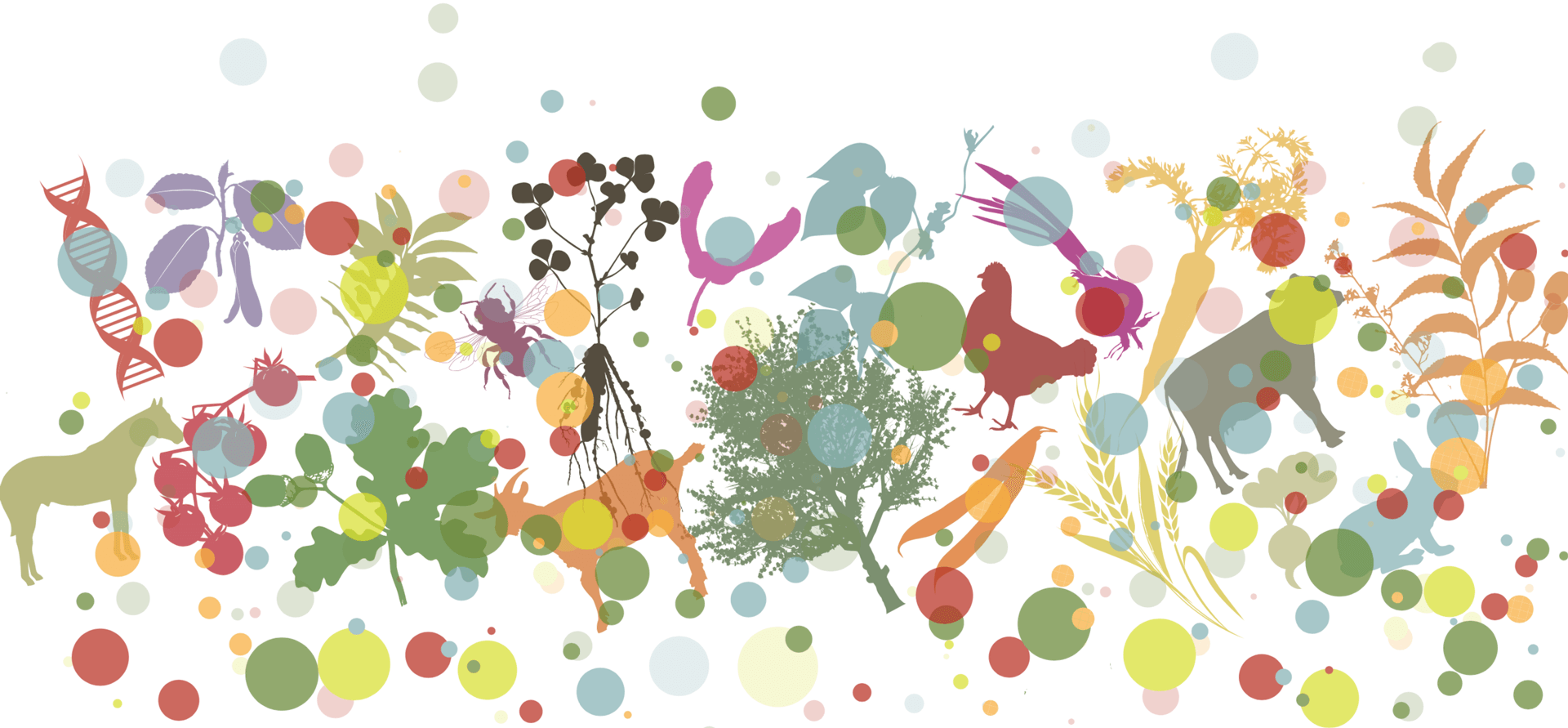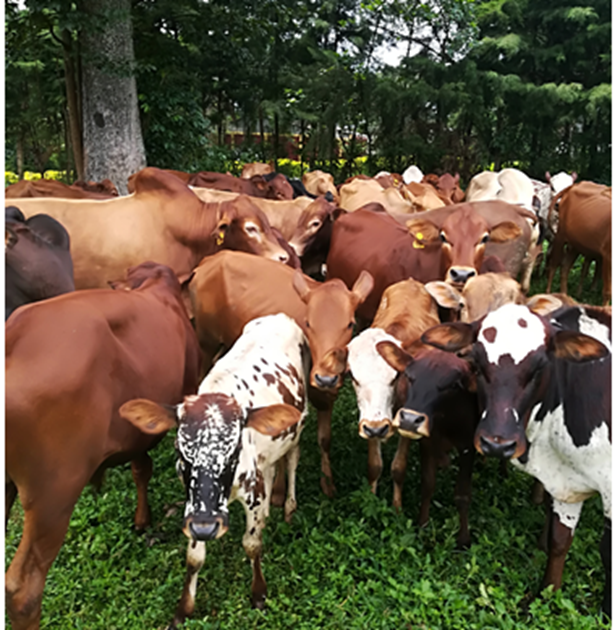Management practice of the Sheko cattle breed in Ethiopia: A review
Main Article Content
Abstract
The great diversity of agroecological conditions and production systems present in Ethiopia contributes to the country’s large livestock population and makes it suitable for various forms of livestock production. The Ethiopian livestock sector provides significant economic and social benefits at household levels and to the national economy. Ethiopia has 32 recognized indigenous cattle breeds, of which the Sheko is a known trypano-tolerant breed found in the southwest of the country. However, in recent times, the Sheko population has been declining mainly due to interbreeding with local Zebu cattle and to a shift in the production system. This paper aims to review and illustrate the current status and management practices of the Sheko cattle breed towards conserving and improving the breed, and the production system. The feed resources in the Sheko home area are natural pasture and crop residues, with limited utilization of cultivated improved forage. Husbandry practices such as feeding, watering, housing and veterinary services are priority areas where improvements are needed. Enhancing the conservation and improvement of the breed would greatly benefit from the active improvement of various stakeholders, including governmental policymakers and non-governmental organizations. Therefore giving special attention to enhancing the management systems in the breed’s home area is crucial. This involves the direct engagement of research centres, extension workers; and higher learning institutions in proximity to the area all aimed at the conservation and improvement of the Sheko cattle breed.
Article Details

This work is licensed under a Creative Commons Attribution 4.0 International License.
Authors retain copyright of the articles published in Genetic Resources and grant the journal right of first publication with open access. All articles published in Genetic Resource are licensed under Creative Commons Attribution 4.0 International License (CC BY 4.0) that allows others to download, share and adapt the work for commercial and non-commercial purposes as long as proper attribution to the original article is given. Genetic Resources permits and encourages authors to post items submitted to the journal (including the publisher's final layout) on personal websites or institutional repositories after acceptance and/or publication, while providing bibliographic details that credit their publication in Genetic Resources.
Alemu, R (2002). A summarized field report on the Status of Sheko cattle Traditionally Managed in the Bench-Maji zone, South-Western Ethiopia. Addis Ababa, Ethiopia: ILRI. URL: https://cgspace.cgiar.org/bitstream/handle/10568/2894/ILRI_2002_AnnualReport.pdf;jsessionid=045C3605E2BF621794F12BAB3ED38990?sequence=1.
Alemu, T (1990). The unexploited potential of improved forages in the mid-altitude and lowland areas of Ethiopia. PANESA/ARNAB (Pastures Network for Eastern and Southern Africa/African Research Network for Agricultural By-products. Utilization of research results on forage and agriculture.
Bayou, E et al. (2014). “Characterizing husbandry practices and breeding objectives of Sheko cattle owners for designing conservation and improvement strategies in Ethiopia”. Livestock Research for Rural Development 26. URL: http://www.lrrd.org/lrrd26/12/bayo26235.html.
Blummel, M et al. (2018). “Ammonia Fiber Expansion (AFEX) as spin off technology from 2nd generation biofuel for upgrading cereal straws and stovers for livestock feed”. Animal Feed Science and Technology 236, pp. 178–186. URL: https://hdl.handle.net/10568/89916. DOI: https://doi.org/10.1016/j.anifeedsci.2017.12.016
Bunke, Y (2019). Productive and Reproductive Performances, Husbandry Practices and Associated Problems of Crossbred and Indigenous Dairy Cattle in Gamo Goffa Zone, SNNPR, Ethiopia.
CSA (2020). Volume II report on livestock and livestock characteristics (private peasant holdings).
Addis Ababa, Ethiopia: Central Statistical Agency (CSA). URL: https://www.statsethiopia.gov.et/wp-content/uploads/2021/05/2013.LIVESTOCK-REPORT.FINAL_.pdf.
DAGRIS (2007). Domestic Animal Genetic Resources Information System. International Livestock Research Institute. URL: http://pigtrop.cirad.fr/content/pdf/4199 (visited on 11/17/2016).
Dawit, A (1992). Prevalence of Bovine Trypanosomiasis in Gimera/Sheko and Zebu Cattle under Natural Condition in Gimera Awraja, Kaffa Administrative Region. Ethiopia.
Dessie, T (2012). Biodiversity, resource base, animal breed level characterization, and utility of the information for goat genetic resources in Ethiopia.
Desta, T T, W Ayalew, and B P Hegde (2011). “Breed and trait preferences of Sheko cattle keepers in southwestern Ethiopia”. Tropical Animal Health and Production 43(4), pp. 851–856. DOI: https://doi.org/10.1007/s11250-010-9772-2.
Desta, T T, W Ayalew, and P B Hegde (2012). “Farmers perceptions on trypanosomosis and trypanotolerance character of the taurine Sheko”. Tropical Animal Health and Production 44(3), pp. 609–616. DOI: https://doi.org/10.1007/s11250-011-9943-9. DOI: https://doi.org/10.1007/s11250-011-9943-9
Elias, B (2008). Sheko Cattle: Distribution, Management, and Performance in Bench-Maji zone of SNNPRs. URL: http://etd.aau.edu.et/handle/123456789/21661.
Fasil, M (2004). Prevalence of Trypanosomiasis among Domestic Animals in Bench Maji Zone, Mizan Teferi. Ethiopia. URL: https://doi.org/10.5897/JVMAH2016.0464. DOI: https://doi.org/10.5897/JVMAH2016.0464
Garg, M R et al. (2014). “Effect of feeding a balanced ration on milk production, microbial nitrogen supply and methane emissions in field animals”. Animal Production Science 54(10), pp. 1657–166. DOI: https://krishi.icar.gov.in/jspui/bitstream/123456789/12174/1/493-1-2796-2-1020180712.pdf. DOI: https://doi.org/10.1071/AN14163
Hailu, A (2020). “Evaluation of husbandry practices and constraints for cattle fattening in Bench Maji zone, south west Ethiopia”. International Journal for Research in Agricultural and Food Science 6(1), pp. 32–48. URL: https://gnpublication.org/index.php/afs/article/download/1176/851/.
Hanotte, O et al. (2000). “Geographic distribution and frequency of a taurine Bos taurus and an indicine Bos indicus Y specific allele amongst sub-Saharan African cattle breeds”. Molecular Ecology 9(4), pp. 387–396. DOI: https://doi.org/10.1046/j.1365-294X.2000.00858.x. DOI: https://doi.org/10.1046/j.1365-294x.2000.00858.x
Hegde, B P (2005). Cattle breeding strategy to improve milk production in Ethiopia. Alemaya University. Unpublished manuscript. URL: https://hdl.handle.net/10568/3141.
Kitila, G et al. (2017). “Epidemiological investigation of bovine trypanosomosis and its vector apparent densities in Yayo District Illuababora Zone, Western Oromia”. Ethiopia. Austin J. Vet. Sci. Anim. Husb 4, pp. 1–6. DOI: https://doi.org/10.1016/j.parepi.2021.e00218. DOI: https://doi.org/10.26420/austinjvetscianimhusb.2017.1031
Lund, V (2002). Ethics and animal welfare in organic animal husbandry an interdisciplinary approach. URL: https://res.slu.se/id/publ/0.
Makkar, H P S (2018). “Feed demand landscape and implications of food-not feed strategy for food security and climate change”. Animal 12(8), pp. 1744–1754. DOI: https://doi.org/10.1017/S175173111700324X. DOI: https://doi.org/10.1017/S175173111700324X
Matope, A et al. (2020). “Mitigating the effects of drought on cattle production in communal rangelands of Zimbabwe”. Tropical Animal Health and Production 52(1), pp. 321–330. DOI: https://doi.org/10.3390/su131810023. DOI: https://doi.org/10.1007/s11250-019-02020-y
Mekuriaw, G and A Kebede (2015). “A Review on Indigenous Cattle Genetic Resources in Ethiopia: Adaptation, Status and Survival”. Online Journal of Animal and Feed Research 5(5), pp. 125–137. URL: http://www.science-line.com/index/.
Mengistu, G et al. (2017). “Survey on livestock production system characterization in Bench-Maji, Sheka and Mejenger Zones”. International Journal of Research in Agricultural Sciences 4(5), pp. 2348–3997. URL: https://ijras.org/administrator/components/com_jresearch/files/publications/IJRAS_594_FINAL.pdf.
MOA (1984). Livestock Sub Sector Reviews. Main Report. Ethiopia: Ministry of Agriculture.
MOA (2013). Major challenges and achievements in Ethiopian livestock production. Presentation.
Ministry of Agriculture (MOA): Addis Ababa, Ethiopia. URL: https://slideplayer.com/slide/7321828/.
Seyoum, Z, G Terefe, and H Ashenafi (2013). “Farmers’ perception of impacts of bovine trypanosomosis and tsetse fly in selected districts in Baro-Akobo and Gojeb river basins, Southwestern Ethiopia”. BMC veterinary research 9(1), pp. 1–9. DOI: https://doi.org/10.1177/11786302221127266. DOI: https://doi.org/10.1186/1746-6148-9-214
Stein, J et al. (2011). “Trypanosomosis and phenotypic features of four indigenous cattle breeds in an Ethiopian field study”. Veterinary Parasitology 178(1-2), pp. 40–47. DOI: https://doi.org/10.1016/j.vetpar.2010.12.025. DOI: https://doi.org/10.1016/j.vetpar.2010.12.025
Takele, T (2005). On-farm Phenotypic Characterization of Sheko Breed of Cattle and Their Habitat in Bench Maji Zone. Ethiopia. URL: https://www.researchgate.net/publication/269763438.
Takele, T and L Habtamu (2009). “Traditional Backyard Cattle Fattening in Wolayta: Systems of Operation and the Routine Husbandry Practices”. Ethiopian Journal of Animal Production 9(1), pp. 39–56.
Takele, T and A Workneh (2011). “Hegde Breed and trait preferences of Sheko cattle keepers in southwestern Ethiopia”. Tropical Animal Health and Production(43), pp. 851–856. URL: https://www.researchgate.net/publication/237100111. DOI: https://doi.org/10.1007/s11250-010-9772-2
Taye, T, W Ayalew, and B P Hegde (2009). “Status of Ethiopian indigenous Sheko cattle breed and the need for participatory breed management plan”. Ethiopian Journal of Animal Production 9(1). URL: https://www.researchgate.net/publication/237100090.
Terefe, E et al. (2012). “Husbandry and breeding practices of cattle in Mursi and Bodi pastoral communities in Southwest Ethiopia”. African Journal of Agricultural Research 7(45), pp. 5986–5994. DOI: https://doi.org/10.5897/AJAR12.1566. DOI: https://doi.org/10.5897/AJAR12.1566
Tolera, A, A Yami, and D Alemu (2012). Livestock feed resources in Ethiopia: Challenges, Opportunities and the need for transformation. URL: https://www.researchgate.net/publication/312692080.
Walli, T K, M R Garg, and H P Makkar (2012). Crop residue based densified total mixed ration. FAO Animal Production and Health Paper n. 172. URL: https://www.fao.org/3/i2728e/i2728e00.pdf.
Workeneh, A (2001). “Revised field report on a survey of a sample of the Sheko cattle maintained at the former Tolley military Training Center in Oromiya Regional State, Ethiopia”. In: Addis Ababa, Ethiopia: Oromiya Agricultural Development Bureau, ILRI. URL: http://etd.aau.edu.et/bitstream/handle/123456789/21661/ELIAS%20BAYOU%202008.pdf?sequence=1%5C&isAllowed=y.
World Bank (2007). World Development Report 2008: Agriculture for development. URL: https://digitallibrary.un.org/record/1305297?ln=en. DOI: https://doi.org/10.1596/978-0-8213-6807-7
Zander, K K, A G Drucker, and K Holm-Müller (2009). “Costing the conservation of animal genetic resources: The case of Borana cattle in Ethiopia and Kenya”. Journal of arid environments 73(4-5), pp. 550–556. DOI: https://doi.org/10.1371/journal.pone.0244836. DOI: https://doi.org/10.1016/j.jaridenv.2008.11.003







 This journal has been conceived as part of the
This journal has been conceived as part of the